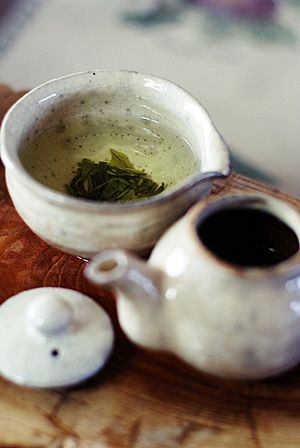Sejak facts for kids

Sejak green tea from Hadong County
|
|
| Type | Nokcha (green tea) |
|---|---|
| Country of origin | Korea |
| Ingredients | Second-flush tea leaves |
| Korean name | |
| Hangul |
세작
|
|---|---|
| Hanja |
細雀
|
| Revised Romanization | sejak |
| McCune–Reischauer | sejak |
| IPA | [se.dʑak̚] |
| Alternative name | |
| Hangul |
두물차
|
| Hanja |
--茶
|
| Revised Romanization | dumul-cha |
| McCune–Reischauer | tumul-ch'a |
| IPA | [tu.mul.tɕʰa] |
| Epithet | |
| Hangul |
작설
|
| Hanja |
雀舌
|
| Revised Romanization | jakseol |
| McCune–Reischauer | chaksŏl |
| IPA | [tɕak.s͈ʌl] |
Sejak is a special type of green tea from Korea. It's known for being made from very young and soft tea leaves. These leaves are picked by hand at a specific time of year.
Contents
What is Sejak Tea?
Sejak (pronounced "seh-jak") is a popular Korean green tea. Its name means "thin sparrow" in Korean. This name hints at how delicate the tea leaves are.
It's also called dumul-cha, which means "second flush tea." This refers to when the leaves are picked.
How Sejak Gets Its Name
Another name for sejak is jakseol (pronounced "jak-sul"). This name means "sparrow tongue." It's called this because the tea leaves are picked when they are tiny. They are about the same size as a small sparrow's tongue. This makes the tea very tender and flavorful.
When and How Sejak is Made
The young tea leaves for sejak are picked in the spring. This happens after a time called gogu, which means "grain rain." This is usually around April 20-21. The picking must be finished before ipha, or "advent of summer," which is around May 5-6.
The leaves are carefully hand-plucked during this short period. This ensures that only the freshest and most tender parts of the tea plant are used.
Brewing Your Sejak Tea
To enjoy sejak tea, it's important to brew it correctly. The best temperature for steeping sejak is between 60 and 70 degrees Celsius (about 140-158 degrees Fahrenheit). Using water that is too hot can make the tea taste bitter. This lower temperature helps bring out its delicate flavors.

